Ikura Sushi
A Comprehensive Overview of Red Caviar, Salmon Roe in Japanese Sushi Cuisine
イクラすし 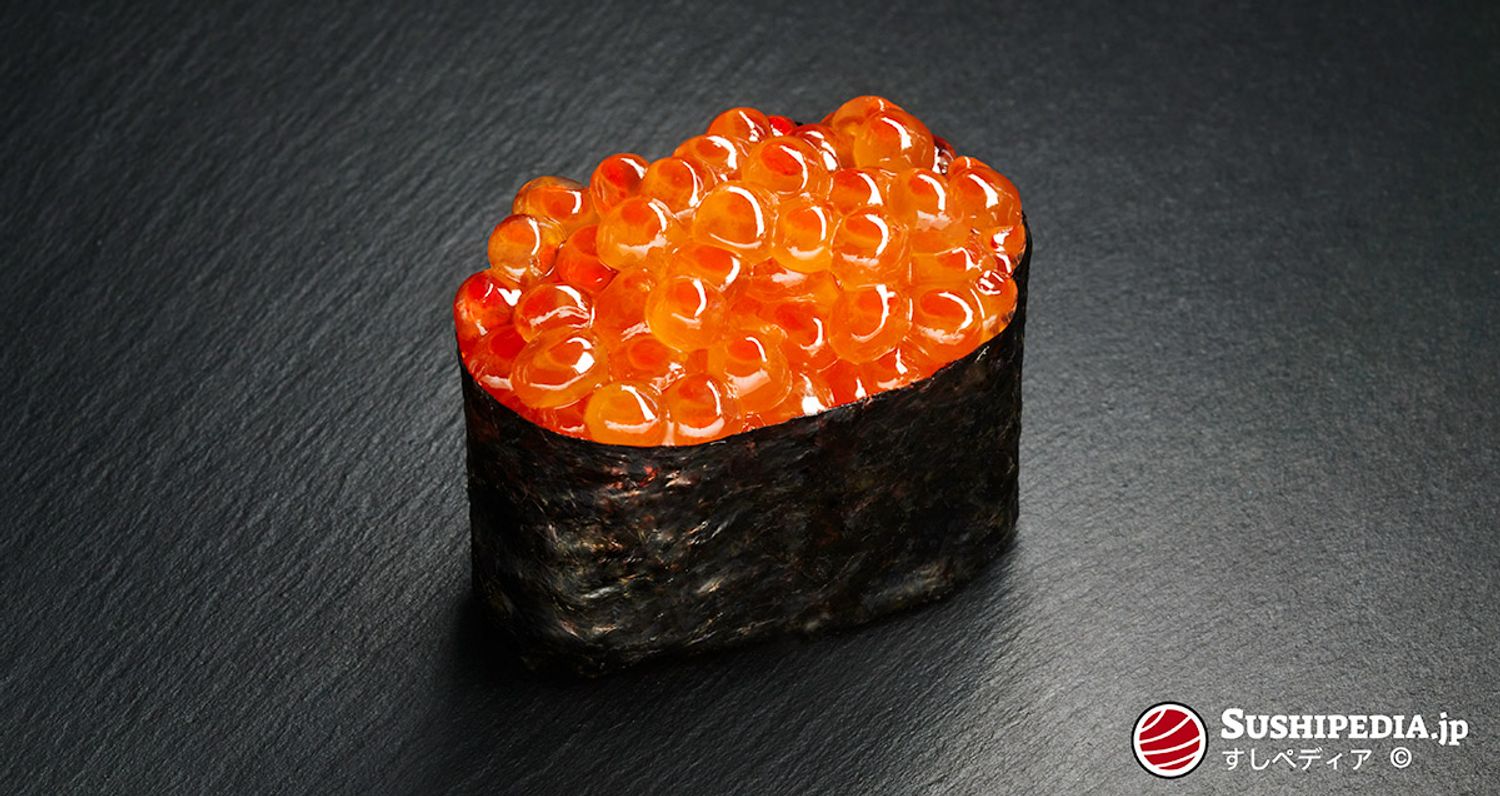
What is Ikura?
Ikura (イクラ) is a Japanese loanword for ikra (икра), the Russian word for the eggs or roe of fish. The Japanese term ikura refers in a narrow sense to the single eggs of salmon, but in a broader sense also includes that of trout.
Salmon or trout caviar can mostly be salted in the form of whole ovaries or strands (sujiko), but more often the individual eggs (ikura) are used. Ikura is one of the modern sushi ingredients, which is very popular as a component for gunkan maki or chirashi sushi. Furthermore, ikura is one of the most consumed and commercially important fish roe products in the world.[1]
Ikura for Sushi or Sashimi
Salmon fish eggs are among the largest fish eggs, with a size of up to 8 mm. They are characterized not only by their good taste, but also by their gloss and transparency. The roe contains between 10 and 20% fat and is traditionally obtained using the so-called malossol technique (Russian for “weakly salted”). In this technique, the roe is separated from the connective tissue by passing the roe sack through sieves and separating the eggs. Today, special enzymes are used for this purpose in industrial processes. Industrially processed ikura is often pasteurized and soaked in saturated salt solution to extend its relatively short shelf life and reduce the risk of foodborne illnesses.[2] In addition, pasteurization allows the use of less salt, which has a positive effect on the taste and texture.[1] Besides processing with a salt solution (shio ikura), ikura can also be pickled in soy sauce and alcohol (shōyu ikura). Especially with regard to the preparation of sushi, soaking in soy sauce, mirin and sake is a popular seasoning method.
Pickling or marinating reduces the fishlike taste and softens the texture of the roe. It also makes it easier to control the taste contrast to normal or soured rice. Ikura is considered to be of high quality if it is of bright color, full of gloss and without wrinkles. They should also yield under slight pressure without tearing or cracking. As soon as the freshness begins to diminish, ikura becomes cloudy or milky, the first signs of cloudiness already reduces the taste.
Most of the fish roe available in the retail market is already ready to eat. Ikura contains a high concentration of protein, essential amino acids, vitamins, and polyunsaturated fatty acids. The quality and taste of ikura is mostly determined by the fish species, processing methods, packaging, and storage conditions.[1]
Best Season
Fresh and unfrozen ikura that has not been pasteurized or otherwise preserved is available for a limited time and regionally. As expected, availability is limited to the season and coastal areas, where the fish is either farmed or returns to the rivers to spawn. In addition, the spawning season has a wide range between species and regions. For example, the king salmon caught off the coast of Alaska begins its ascent into the spawning grounds in early summer, but further south it continues into early fall. Salmon season throughout Alaska ranges from the months of May to September. In Japan, late summer to early fall is considered the best season.
The salted ikura that’s in our freezer—the quality doesn’t change even after one year.
Jiro Ono in Sushi Chef: Sukiyabashi Jiro[3]
Ikura is available all year round in high quality as frozen products in specialized stores, with the majority of supplies consisting of products that have already been pasteurized and/or treated with preservatives. Raw ikura is highly perishable and requires freezing or pasteurization to prevent spoilage. Vacuum-packed or air-tight-packaged non-pasteurized ikura has a shelf life of 1 to 2 years at -20 °C.[4] Refrigerated storage of thawed ikura has a shelf life of 3 to 5 days at 2 °C.[5]
Sujiko
Sujiko 筋子 stands in Japanese for the raw untreated roe which is still surrounded by the ovarian membrane (roe sac). The Japanese term sujiko is composed of 筋 (suji), which in this context is to be understood as “streak”, and 子 for “child” (ko). The name metaphorically refers to the outer appearance of the eggs lined up in the roe sack. The roe sack is removed from the fish together with the immature eggs and further processed. Typical further processing is soaking in a salt solution or soy sauce.
From the sujiko (roe sack), either the individual roes can be extracted (ikura) or the entire sack including the roe can be processed. Depending on the degree of maturity, it can be difficult to extract the individual eggs from the membrane. When preparing raw sujiko, a higher concentration of salt is used than when preparing ikura. This treatment gives the roe a firmer texture and longer shelf life, and also improves the taste. The exact name of the sujiko changes depending on the species of fish, for example, sujiko is called sake-ko for chum salmon (sake) and gin-ko for silver salmon (ginzake).
The use of sujiko as a sushi ingredient, for example as nigiri sushi is rather uncommon in the West. In Japan, however, it is occasionally found as nigiri or gunkan maki in some sushi restaurants. For the preparation of sushi, especially those sujiko are preferred where the roe is not yet fully developed and is therefore smaller.
Production
Ikura and other roe products are considered a valued specialty and, depending on the quality, are traded at high prices. Fish eggs have a high nutritional value and are rich in proteins, lipids, and minerals. To produce ikura, the belly of a female salmon is cut open from the pectoral fin to the anus. Then the ovaries are pulled out and processed. The general procedure of ikura production involves removal of the ovarian membrane and washing to remove blood and mucus. After the roe is strained and mechanically separated, it can be pasteurized, preserved with salt or brined and cured with other ingredients.
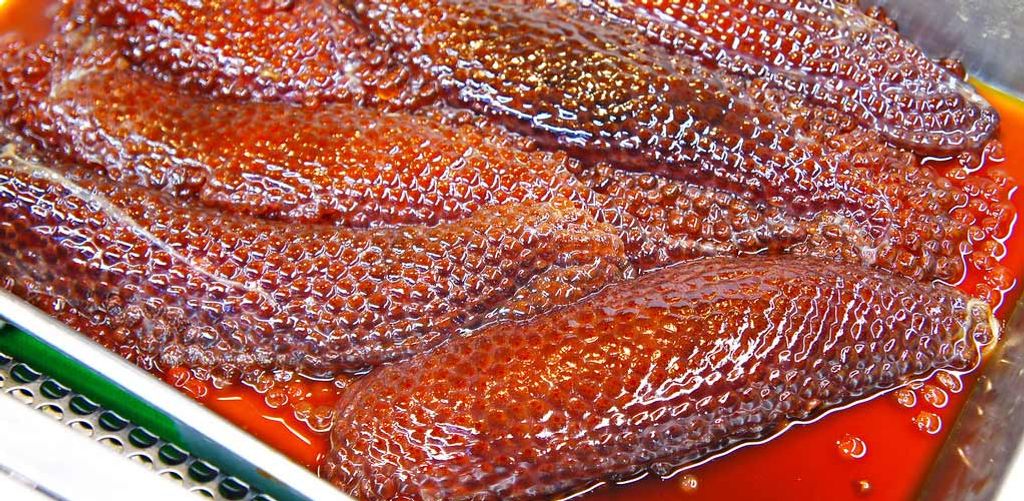
Sundy Lyn. Salmon roe. flickr.com. Some rights reserved: CC BY-SA 2.0. Changes applied: brightness, contrast, noise, white balance
Artificial Salmon Roe
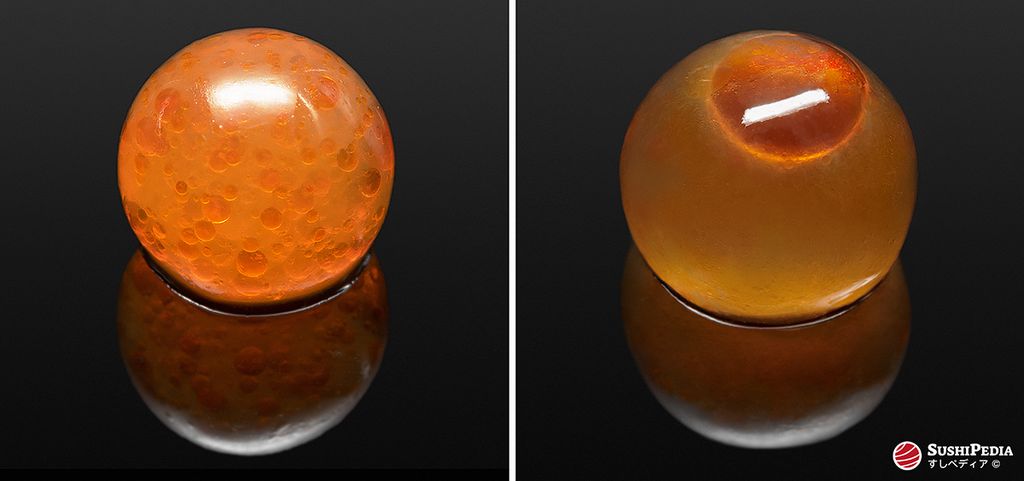
SushiPedia. Artificial ikura versus real ikura. All rights reserved ©
Artificial salmon roe (jinkō ikura 人工イクラ) belongs to the group of substitut foods or copy foods. Artificial salmon roe was invented by the chemical company Nippon Carbide Industries (日本カーバイド工業), which discovered it by accident while researching capsules for pharmaceutical use.[6] It is made mainly from vegetable oils, alginate, carrageenan and seaweed extract. There are also variants to which fish oils or other ingredients of animal origin are added, such as sāmon doroppusu no.2 (サーモンドロップス No.2) from the Kewpie brand.
Depending on the recipe, the taste of artificial salmon roe may be similar to that of natural salmon roe, but less intense and lighter. However, some products available on the market aim to create their own taste experience and bear little resemblance to their natural counterpart in taste and appearance. The physical properties of artificial ikura differ in that it is less sensitive to heat and has a more homogeneous structure. Due to the good availability of cheap salmon or trout roe, artificial ikura is hardly used nowadays. Given the increasing trend toward vegan and plant-based diets, it remains to be seen whether this will lead to increased use of artificial ikura.
Types of Ikura
Atlantic Salmon Ikura (sake-ko サケ子)
In comparison to the roe of the Pacific salmon, that of the Atlantic salmon is more rarely to be found in the trade. The main producers are Norway, Finland and Iceland, whose focus is on the production of roe from aquaculture.[7] Because Atlantic salmon, in particular, is farmed in aquaculture in large quantities, its roe coloration can range from a pale yellow to a dark orange. The diet or feed has a significant influence on the coloration of the roe. The egg size of 5 to 6 mm differs only slightly between wild and farmed specimens.[8]
Pink Salmon Ikura (masu-ko マス子)
In Japan, the humpback salmon is traditionally classified as a trout (masu, 鱒) and not as a salmon (sake, 鮭). However, this classification is only found in the name. It dates back to a time before the establishment of modern science and ichthyology in Japan. The roe of the pink salmon has an intense dark orange to reddish coloration with a very tender skin. The roe has an egg size of 3 to 4 mm, which is slightly smaller than that of other species. The taste of the eggs is less intense than that of the more expensive chum salmon. In trade, Gorbusha Caviar is commonly encountered. This name originates from its scientific name, which is derived from the Russian common name gorbúša (rus. горбуша).
Chum Salmon Ikura (chamu-ko チャム子)
Roe from the chum salmon is considered to be the most valuable of the pacific salmons. Its eggs range in size from 3 to over 5 mm and impress with their bright orange to pale red color.[7] The eggs are relatively soft and sensitive. Ikura of the chum salmon is not only in Japan, considered as one of the most popular varieties and is highly appreciated in the Sushi gastronomy.[9]
Chinook Salmon Ikura (masuno-ko マスノ子)
The roe of the Chinook or king salmon has an average egg size of 6 to 8 mm.[7] The pinkish red color is slightly darker than that of the roe of the chum salmon, the taste is characterized by its mild flavor and is also considered a popular ingredient for sushi.
Sockeye Salmon Ikura (beni-ko ベニ子)
Due to its small egg size of 2 to 3 mm, the roe of the sockeye or red salmon is considered very popular. Of all species used for the preparation of ikura or sujiko, the roe of red salmon is the smallest. Its coloration is strikingly dark red, and its taste is much more bitter than that of the other species.
Coho Salmon Ikura (gin-ko ギン子)
Roe extracted from Coho or silver salmon is similar to sockeye salmon with its bright red color. The size of the single egg resembles with about 4 mm more the roe of the humpback salmon. With its slightly bitter flavors, the mild taste is similar to that of the roe of the sockeye salmon.
Trout Ikura (masu-ko マス子)
Trout also belong to the salmon family (Salmonidae). With regard to the extraction of ikura, rainbow trout, imported brown trout and sea trout are considered the most economically important species. These are mainly farmed in aquaculture facilities and the roe is taken from the animals shortly before spawning. The whole roe sacs are treated in the same way as salmon to produce loose eggs. Compared to salmon eggs, trout eggs are slightly smaller and more orange. As with farmed salmon, the color, and taste reflect to some extent the feed used in the farms.
Characteristics & Ecology of Ikura
The majority of Pacific salmon roe come from Japan, Russia, Canada, and the United States.[2] These Pacific salmon roe are mostly from salmon species in the Pacific Northwest. Part of the total production is also made up of salmon trout, Atlantic salmon and Arctic char.[10] The size and pigmentation of those roes are different. The flavor also differs between species, ranging from a mild to a richer taste. Among the five different species of Pacific salmon, coho salmon, pink salmon, and chum salmon are most commonly used for the production of ikura or salted salmon roe.[2] Especially with regard to the preparation of sushi, the roe of chum salmon is preferred to those of the others. The choice of roe as an ingredient for preparing sushi, however, is more a matter of personal taste than quality. Personal preferences are mostly dependent on the salt commodity, the color, the size of the roe and the taste or seasoning of the ikura.
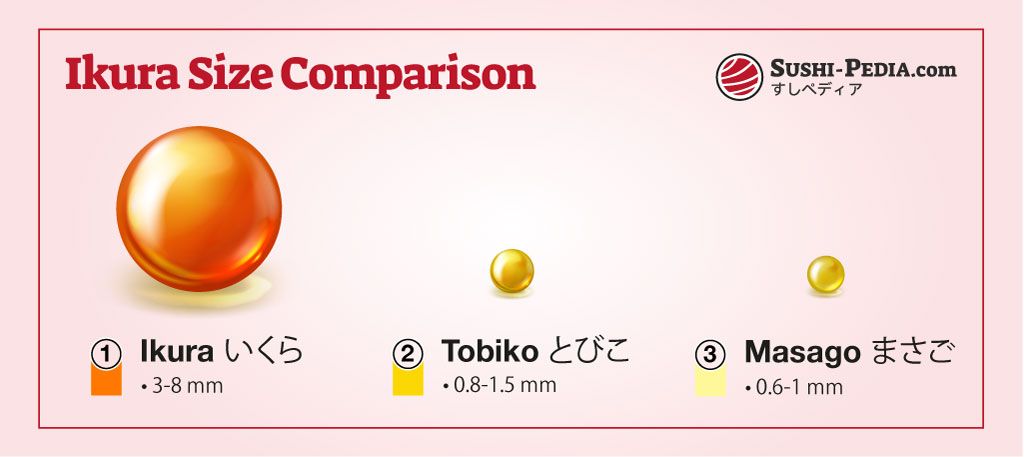
SushiPedia. Size Comparison of Ikura, Tobiko, and Masago. All rights reserved ©
Economy of Ikura
Japan provides the largest market for salmon roe in the world. Japan consumed approximately 1,500 tons of lightly salted eggs (ikura) and 33 tons of heavily salted whole ovaries or strands (sujiko) in 2020.[11]
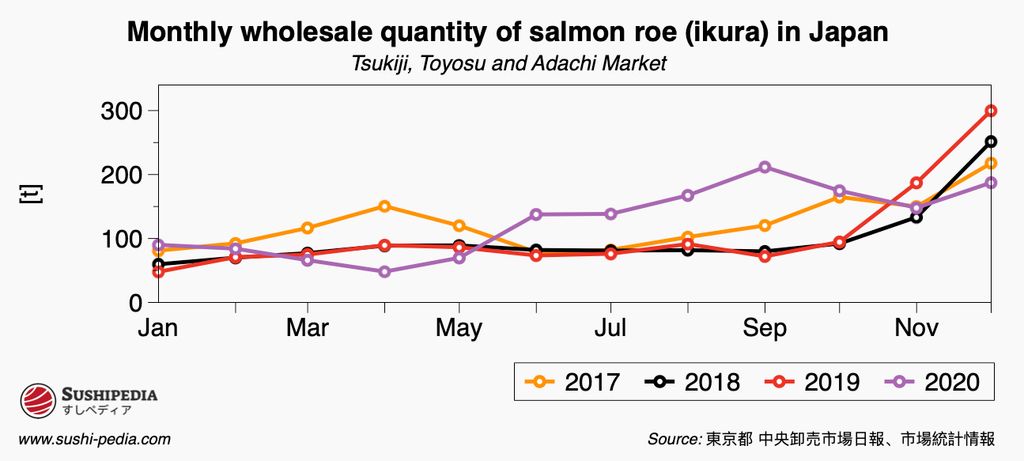
SushiPedia. Monthly Wholesale Quantities of Salmon Roe (Ikura) in Japan. All rights reserved ©
Video about Ikura Sushi
External video embedded from: youTube.com. Credit How To Sushi. How to Make Marinated Ikura (Salmon Roe)【Sushi Chef Eye View】.
Species for Ikura
The following species are regarded as authentic ikura. Either historically, according to the area of distribution or according to the common practice in today's gastronomy: The term ikura encompasses a variety of species that are grouped together under these names. Due to the extensive diversity of these species, it is not always possible to list all specific taxa in this list completely.
In the following, those species are listed that can be considered as substitutes for authentic species with regard to ikura. This can be based either on their genetic relationship or on their similarity in taste and appearance. The selection is subjective and is not strictly based on Japanese conventions, but also takes into account the practices in the respective areas where the Japanese dishes are prepared. This flexible approach allows for adaptation to local availability and preferences while preserving the core flavor and texture traditionally associated with ikura.
Sources and Further Reading
- [1]Mahmoudreza Ovissipour, Chen Liu, Gülhan Ünlü, Barbara Rasco, Juming Tang, Shyam S. Sablani. Quality Changes in Chum Salmon (Oncorhynchus keta) Caviar (ikura) Affected by Thermal Pasteurization, Storage Time, and Packaging Material. Journal of Aquatic Food Product Technology 27 (2). 2018. DOI: 10.1080/10498850.2017.1417340.
- [2]G.E. Bledsoe , C.D. Bledsoe & B. Rasco. Caviars and Fish Roe Products. Critical Reviews in Food Science and Nutrition 43 (3) 317-356. 2003. DOI: 10.1080/10408690390826545.
- [3]Shinzo Satomi. Sukiyabashi Jiro. Vertical Inc., New York. 2016
- [4]V. Sternin, Ian Doré. Caviar : The Resource Book. Cultura, Moscow. 1993
- [5]Brian H. Himelbloom, Charles A. Crapo. Microbial Evaluation of Alaska Salmon Caviar. Journal of Food Protection 61 (5) 626-628. 1997. DOI: 10.4315/0362-028x-61.5.626.
- [6]紙尾康作. 『何をどうしてつくるか、化学がつくるコピ、食品の精粋、人造イクラ (What To Create and Why, Copies Made by Chemistry, Refinement of Food, Artificial Salmon Eggs)』. 化学 39 (1) 35-38. 1984
- [7]Yiu H. Hui. Handbook of Food Science, Technology, and Engineering, Vol. 4. CRC-Press, Taylor & Francis Group, Boca Raton. 2006
- [8]L. Walravens. Assessing the quality of Atlantic salmon (Salmo salar) eggs. Faculté des bioingénieurs, Université catholique de Louvain. Prom.: Y. Larondelle, X. Rollin. 2018
- [9]Nick Sakagami. Sushi Master: An expert guide to sourcing, making and enjoying sushi at home. Quarry Books, Beverly. 2019
- [10]Stephanie Clark, Stephanie Jung, Buddhi Lamsal. Food Processing: Principles and Applications. John Wiley & Sons, Chichester
- [11]『市場統計情報、月報 (Market statistics, monthly reports)』. 東京都 中央卸売市 (Tokyo Central Wholesale Market). 2021. Source retrieved 4/20/2021
- Furukawa Tomoko (古川知子). Healthy Food Encyclopedia (食材健康大事典). Jiji Press, Tokyo (時事通信出版局, 東京都). 2005
- George M. Hall. Fish Processing: Sustainability and New Opportunities. John Wiley & Sons, Chichester
- Roy E. Martin, Emily Paine Carter, George J. Flick, Jr., Lynn M. Davis. Marine and Freshwater Products Handbook. CRC Press, Taylor & Francis Group, Boca Raton. 2000
- IUCN Red List of Threatened Species. Version 2023-1
Image Credits
- SushiPedia. Size Comparison of Ikura, Tobiko, and Masago. All rights reserved ©
- SushiPedia. Artificial ikura versus real ikura. All rights reserved ©
- SushiPedia. Ikura Sushi. All rights reserved ©
- SushiPedia. Monthly Wholesale Quantities of Salmon Roe (Ikura) in Japan. All rights reserved ©
- Sundy Lyn. Salmon roe. flickr.com. Some rights reserved: CC BY-SA 2.0. Changes applied: brightness, contrast, noise, white balance